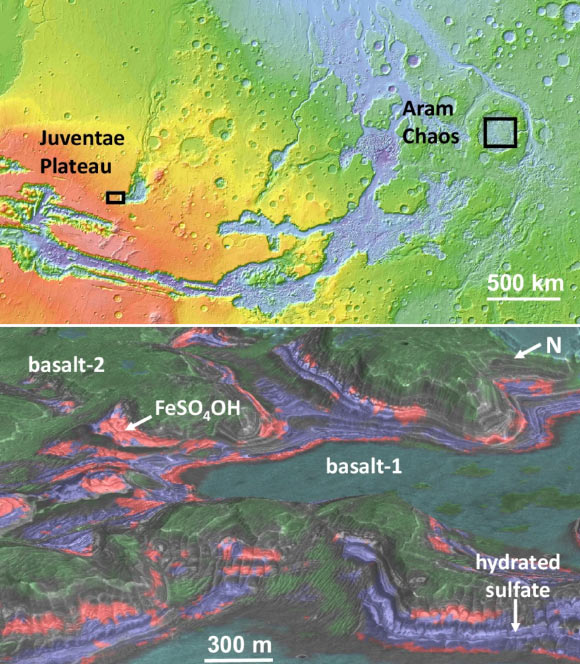The newly-discovered mineral, named ferric hydroxysulfate, provides clues about the environment and history of the Red Planet, including the possibility of former lava, ash or hydrothermal activity.
Spectrally distinct units at the Juventae Plateau, Mars. Image credit: Bishop et al., doi: 10.1038/s41467-025-61801-2.
The Compact Reconnaissance Imaging Spectrometer for Mars (CRISM) instrument aboard NASA’s Mars Reconnaissance Orbiter has provided hyperspectral data for mapping numerous minerals that guide our understanding of the ancient geochemical history of Mars.
A variety of sulfate minerals have been identified on Mars from orbital and landed missions through comparison with terrestrial minerals using spectral parameters, X-ray diffraction, and elemental abundances.
In 2010, an unusual spectral band was discovered in CRISM spectra of Mars at the plateau bordering Juventae Chasma and in the heavily eroded impact crater Aram Chaos.
It has provided a challenge for mineral identification for over 15 years because this spectral band is not consistent with any known minerals.
Preliminary lab investigations proposed dehydrated iron sulfates as the source of this unexplained material.
“The data that come out of the spectrometer is not usable the way it is,” said Dr. Mario Parente, a researcher at the University of Massachusetts, Amherst.
“We have to calibrate the data, correct the data, remove the effect of the atmosphere.”
“The light — which travels from the Sun to the mineral to CRISM — has to go through the Martian atmosphere twice.”
“There are scattering molecules and gases that absorb light in the atmosphere,” he says. “For example, on Mars, there is an abundance of carbon dioxide, and that will distort the data.
Using deep learning artificial intelligence approaches, the researchers can map the known and unknown minerals, automatically recognizing anomalies in the individual pixels of an image.
They revealed additional locations on the planet with the same spectral band and clarified additional spectral features.
From the newly-refined characteristics, they were able to reproduce the mineral in the lab and determined the mystery compound as ferric hydroxysulfate.
“The material formed in these lab experiments is likely a new mineral due to its unique crystal structure and thermal stability,” said Dr. Janice Bishop, a researcher at the SETI Institute and NASA’s Ames Research Center.
“However, scientists must also find it on Earth to officially recognize it as a new mineral.”
Ferric hydroxysulfate forms at high temperatures (50 to 100 degrees Celsius) in an acidic environment and in the presence of oxygen and water.
“Once you make a mineral attribution and you have good indications of a certain material, then you can start thinking about: When does this material occur? In what condition does it form?” Dr. Parente said.
The scientists concluded that ferric hydroxysulfate was formed at Aram Chaos via geothermal heat, while the same mineral was formed at Juventae through volcanic heating by ash or lava.
They speculate that this likely happened during the Amazonian period, less than 3 billion years ago.
“Temperature, pressure and conditions such as pH are all very important indications of what the paleoclimate was,” Dr. Parente said.
“The presence of this mineral puts a lot more nuance on what was going on.”
“Parts of Mars have been chemically and thermally active more recently than we once believed — offering new insight into the planet’s dynamic surface and its potential to have supported life.”
The study was published in the journal Nature Communications.
_____
J.L. Bishop et al. 2025. Characterization of ferric hydroxysulfate on Mars and implications of the geochemical environment supporting its formation. Nat Commun 16, 7020; doi: 10.1038/s41467-025-61801-2

